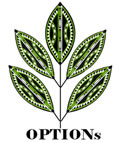Strychnos spinosa
Fact sheet about Strychnos spinosa
Distribution and habitat
S. spinosa occurs in savannah forests all over tropical Africa and grows in open woodland and riverine fringes. Native: Ethiopia, Kenya, Madagascar, Mali, Mauritius, Seychelles, Sudan, Tanzania, Uganda, Zambia. Exotic to: South Africa, United States of America. The tree can be found growing singly in well-drained soils. It is found in bushveld, riverine fringes, sand forest and coastal bush from the Eastern Cape, to Kwazulu-Natal, Mozambique and inland to Swaziland, Zimbabwe, northern Botswana and northern Namibia, north to tropical Africa. This tree prefers sandy soils and grows fast in rocky areas. Prefers full sun and requires moderate amount of water.
Flowering and fruiting habits
It is a small to medium sized, spiny deciduous tree with green leaves turning yellow in autumn, with a flat, irregular, heavily branched canopy. Leaves are simple, opposite, elliptic- ovate up to 9 x 7.5 cm, margin entire, petiole 2-10 mm long. Flowers are creamy-green, up to 6 mm long, in compact heads, terminal on short lateral twigs. Fruits are round, woody-shelled, 5-12 cm wide, yellow to brown when mature; containing many tightly packed flat seeds with fleshy, edible covering.
Uses other than pesticidal
Medicinal- Compounds from S. spinosa tree have been shown to have anti-trypanocidal activity. A decoction of the leaf or root is used as an analgesic in Central Africa.
Other uses- The wood can be used for general carpentry. Timber from S. spinosa produces handles, fighting sticks and hut poles. It is also used for carving. Dried fruit, after the seeds are removed, are often used as sounding-boxes for musical instruments such as the marimba. They are also carved and sold as curios.
The fruit is edible and often sun dried as a food preserve.
Propagation and cultivation
S. spinosa species can be regenerated from root suckers and coppice or seeds. Seeds are soaked in hot water or the hard coat is burned to facilitate and improve germination. It can also be propagated vegetatively.
Seed collection & Storage
Fruits are harvested when the colour turns from green to yellow brown. Harvesting is by cutting the branches holding the fruit using a pair of secateurs. A canvas could be spread on the ground to hold the fruits during harvesting. After collection, fresh fruits are soaked in water to soften the fresh pulp and are extracted by rubbing with hands to remove the pulp; they are then squeezed to release the seeds. After extraction and cleaning seeds must be dried under shade by spreading them out in a thin layer with regularly turning to avoid overheating.
Seed storage behaviour is orthodox; long-term storage. There are about 1800 seeds/kg.
Parts used
Fruits
Preparation
Aqueous fruit extracts made at 5% w/v
Uses
Surface application
Target organisms
Against cattle ticks

